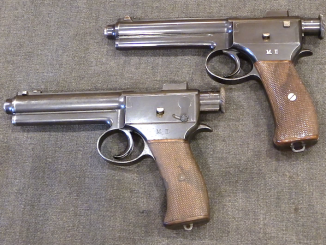The WALAM 48 was a copy of the Walther Model PP made by Fegyver- és Gépgyártó Részvénytársaság (aka FÉG) in Hungary in the years after World War Two. It was originally produced as the 48M police pistol (in .32 caliber) to replace the aging stocks of Frommer Stop pistols used by Hungarian police. Once that contract was completed, FÉG moved to looking for commercial and export sales. In 1957 a deal was worked out with General Nasser in Egypt to sell a version of the 48M as well as the Tokagypt copy of the TT33 for the Egyptian military. The gun was called the WALAM 48, meaning “WAlther- LÁMpagyár” (the factory name at that time). This model was chambered for 9x17mm (aka 9mm Browning Short, aka .380 ACP) and 10,000 were ordered. The contract was cancelled prior to completion for unclear reasons, resulting in some pistols being made with an Egyptian crest on the slide and some with blank slides.




“The contract was cancelled prior to completion for unclear reasons”
Somebody didn’t pay the baksheesh
Interesting that the labeling is neither in Magyar nor in Arabic
A.B.Zhuk states that English-language description are specific to commercial variant of 48M, see 31-11 here: http://www.earmi.it/armi/atlas/195.htm
He consider Atilla-Pistole to be different from 48M noting that it has frame made of light white-colored alloy whilst for 48M frame is steel.
Hungary produced several pistols based on the Walther PP/PPK. The shiny (I read it’s Aluminium) model was made for Hungary’s military, and also sold to the civilian market. In Germany, you can currently get one of those for as little as 75€ in used condition.
The PA-63. Those things are as common as hydrogen and boy, such a crappy gun!
I wish you had shown the mechanically totally different automatic safeties of both weapons.
The Walther has a vertically moving block in the grip that blocks the hammer from reaching the firing pin as long as it is not cocked. The fring pin itself can move freely all the time. That is why accidents have happened when dropping the loaded pistol.
The WALAM on the other hand has a firing pin with a horizontal stud that rests in a slot in the breech. It cannot move forward. When the WALAM is cocked, a pin raises from the grip and lifts the rear end of the firing pin out of its slot. This allows the fring pin to go forward and ignite the primer. I think this increases drop safety of the uncocked pistol.
In the end, the WALAM arrangement is closer to the P38, where the firing pin is also blocked as long as the hammer is not cocked.
Commercial variants of the WALAM in 7.65 Browning were marketed by German wholesalers Eduard Kettner as “FEG Attila” and by HEGE (Hebsacker) as “AP66”. Like the PA-63 they have no laoding indicator.
The first design featuring a firing pin safety that remained engaged until the trigger was pulled was in my opinion the Czechoslovak 7.65 mm vz50.
Provision for firing pin safety on CZ 50/70 is indeed very different than that on Walther PP. Firing pin on CZ is free to move forward only after Triger is fully depressed. I took a close look at both at the same time. Quite interesting since externally they look similar.
In fact, PA63 has a chamber loaded indicator, extractor rotates visibly outside by push of case head. Its magazine follower also has a different slide stop actuator tip swinging outside at the top providing ensured slide catch…
PA models have aluminium frames and are all made of cast and machined process. Especially early productions are prone to crack around the barrel housing and trigger guard rotation axis pin.
The reasons for terminating the contract are well known.
There was a serious manufacturing defect in these pistols.
After 30-50 shots, they stopped shooting.
Perhaps not all, but these same pistols, made for the “Arab League”, suffered from this en masse.
Question of curiosity: how come factory passed them? Or they did not shoot them more than one magazine at final inspection? How about verification samples? I know this is hard to trace so far back.
When I found out about this, the words “sabotage” and “incorrect barrel fixation” sounded…
But this seems dubious to me.
I think the point is the banal lack of a competent technologist.
It is unlikely that the factory experienced weapons with a large number of shots, and problems did not begin immediately and not on all pistols.
Perhaps this will explain why it is little known in the west. “Natural selection”, defective pistols were withdrawn from circulation and did not enter the civilian market.
At least the ones sold on the civilian market were apparently of acceptable quality. They were sold in Germany by the truckload.
The gun itself, if it is made with sufficient quality, is quite good. Unsurprisingly, it is almost Walther, and Hungarians are almost Austrians. 😉
I can say about these pistols that I saw about a dozen of them. They differed mainly in emblems. It seems that everything is working. A couple was shot “in a bucket.”
Was there and white, or two.
All quality work. Do not compare with the Chinese TT.
The left pad was broken on one or two.
I also remembered.
Not just broken, but right through holes on the ledge under the finger.